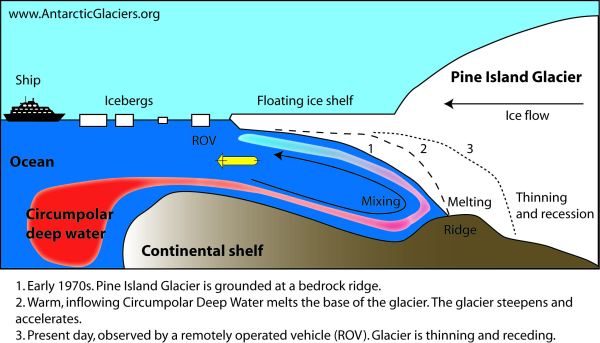Gigantic Iceberg Disintegrates as Concern Grows Over Glacier Stability, Sea Level Rise
4
December, 2017
The
stability of a key Antarctic glacier appears to have taken a turn for
the worse as a large iceberg that broke off during September has
swiftly shattered. Meanwhile, scientists are concerned that the rate
of sea level rise could further accelerate in a world forced to
rapidly warm by human fossil fuel burning.
(Iceberg
drifting away from the Pine Island Glacier rapidly shatters. Image
source: European
Space Agency.)
This
week, a
large iceberg that recently calved from West Antarctica’s Pine
Island Glacier rapidly and unexpectedly disintegrated as
it drifted away from the frozen continent. The iceberg, which covers
103 square miles, was predicted to drift out into the Southern Ocean
before breaking up. But just a little more than two months after
calving in September, the massive chunk of ice is already falling
apart.
The
break-off and disintegration of this large berg has caused Pine
Island Glacier’s ice front to significantly retreat. From 1947 up
until about 2015, the glacier’s leading edge had remained
relatively stable despite significant thinning as warmer water began
to cut beneath it. But since 2015, this key West Antarctic glacier
has begun to rapidly withdraw. And it now dumps 45 billion tons of
ice into the world ocean each year.
(Glaciers
like Pine Island balance on a geological razor’s edge. Because they
sit on a reverse slope, it only takes a relatively moderate amount of
ocean warming to precipitate a rapid collapse. These collapses have
happened numerous times in the past when the Earth warmed. Now,
human-forced climate change is driving a similar process that is
threatening the world’s coastal cities. Image source: Antarctic
Glaciers.)
The
present rate of melt is enough to raise sea levels by around 1
millimeter per year. That’s not too alarming. But there’s concern
that Pine Island Glacier will speed up, dump more ice into the ocean
and lift seas by a faster and faster rate.
Pine
Island Glacier and
its sister glacier Thwaites together
contain enough water to raise
seas by around 3-7 feet.
The glacier sits on a reverse slope that allows more water to flood
inland, exposing higher and less stable ice cliffs as the glacier
melts inland. If the glacier melts too far back and the ice cliffs
grow too high, they could rapidly collapse — spilling a very large
volume of ice into the ocean over a rather brief period of time. As a
result, scientists are very concerned that Pine Island could swiftly
destabilize and push the world’s oceans significantly higher during
the coming years and decades.
No
one is presently predicting an immediate catastrophe coming from the
melt of glaciers like Pine Island. However, though seemingly stable
and slow moving, glacial stability can change quite rapidly. Already,
sea level rise due to melt from places like Greenland and Antarctica
is threatening many low-lying communities and nations around the
world. So the issue is one of present and growing crisis. And there
is very real risk that the next few decades could see considerable
further acceleration of Antarctica’s glaciers as a result of
human-forced warming due to fossil fuel burning.
Dr
Robert Larter, a marine geophysicist at British Antarctic Survey, who
has researched Pine Island Glacier in his work with the Alfred
Wegener Institute, recently
noted to Phys.org:
“If the ice shelf continues to thin and the ice front continues to retreat, its buttressing effect on PIG will diminish, which is likely to lead to further dynamic thinning and retreat of the glacier. PIG already makes the largest contribution to sea-level rise of any single Antarctic glacier and the fact that its bed increases in depth upstream for more than 200 km means there is the possibility of runway retreat that would result in an even bigger contribution to sea level.”
CREDITS:
Hat
tip to Colorado Bob
Hat
tip to Erik Friedrickson


No comments:
Post a Comment
Note: only a member of this blog may post a comment.